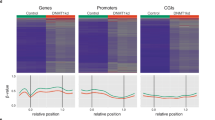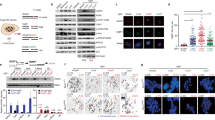Abstract
Observations that genome-wide DNA hypomethylation induces genome instability and tumors in animals caution against the indiscriminate use of demethylating agents, such as 5-aza-2′-deoxycytidine (5-Aza-dC). Using primary mouse embryonic fibroblasts harboring a lacZ mutational reporter construct that allows the quantification and characterization of a wide range of mutational events, we found that, in addition to demethylation, treatment with 5-Aza-dC induces γ-H2AX expression, a marker for DNA breaks, and both point mutations and genome rearrangements. To gain insight into the source of these mutations, we first tested the hypothesis that the mutagenic effect of 5-Aza-dC may be directly mediated through the DNA methyltransferase 1 (DNMT1) covalently trapped in 5-Aza-dC-substituted DNA. Knockdown of DNMT1 resulted in increased resistance to the cytostatic effects of 5-Aza-dC, delayed onset of γ-H2AX expression and a significant reduction in the frequency of genome rearrangements. There was no effect on the 5-Aza-dC-induced point mutations. An alternative mechanism for 5-Aza-dC-induced demethylation and genome rearrangements via activation-induced cytidine deaminase (AID) followed by base excision repair (BER) was found not to be involved. That is, 5-Aza-dC treatment did not significantly induce AID expression and inhibition of BER did not reduce the frequency of genome rearrangements. Thus, our results indicate that the formation of DNMT1 adducts is the prevalent mechanism of 5-Aza-dC-induced genome rearrangements, although hypomethylation per se may still contribute. As the therapeutic effects of 5-Aza-dC greatly depend on the presence of DNMT1, the expression level of DNA methyltransferases in tumors may serve as a prognostic factor for the efficacy of 5-Aza-dC treatment.
This is a preview of subscription content, access via your institution
Access options
Subscribe to this journal
Receive 50 print issues and online access
$259.00 per year
only $5.18 per issue
Buy this article
- Purchase on Springer Link
- Instant access to full article PDF
Prices may be subject to local taxes which are calculated during checkout





Similar content being viewed by others
References
Jones PA, Baylin SB . The epigenomics of cancer. Cell 2007; 128: 683–692.
Santi DV, Norment A, Garrett CE . Covalent bond formation between a DNA-cytosine methyltransferase and DNA containing 5-azacytosine. Proc Natl Acad Sci USA 1984; 81: 6993–6997.
Lengauer C, Kinzler KW, Vogelstein B . DNA methylation and genetic instability in colorectal cancer cells. Proc Natl Acad Sci USA 1997; 94: 2545–2550.
Chen RZ, Pettersson U, Beard C, Jackson-Grusby L, Jaenisch R . DNA hypomethylation leads to elevated mutation rates. Nature 1998; 395: 89–93.
Amacher DE, Turner GN . The mutagenicity of 5-azacytidine and other inhibitors of replicative DNA synthesis in the L5178Y mouse lymphoma cell. Mutat Res 1987; 176: 123–131.
Hernandez R, Frady A, Zhang XY, Varela M, Ehrlich M . Preferential induction of chromosome 1 multibranched figures and whole-arm deletions in a human pro-B cell line treated with 5-azacytidine or 5-azadeoxycytidine. Cytogenet Cell Genet 1997; 76: 196–201.
Jackson-Grusby L, Laird PW, Magge SN, Moeller BJ, Jaenisch R . Mutagenicity of 5-aza-2′-deoxycytidine is mediated by the mammalian DNA methyltransferase. Proc Natl Acad Sci USA 1997; 94: 4681–4685.
Kelecsenyi Z, Spencer DL, Caspary WJ . Molecular analysis of 5-azacytidine-induced variants in mammalian cells. Mutagenesis 2000; 15: 25–31.
Landolph JR, Jones PA . Mutagenicity of 5-azacytidine and related nucleosides in C3H/10 T 1/2 clone 8 and V79 cells. Cancer Res 1982; 42: 817–823.
Zimmermann FK, Scheel I . Genetic effects of 5-azacytidine in Saccharomyces cerevisiae. Mutat Res 1984; 139: 21–24.
Garcia AM, Busuttil RA, Rodriguez A, Cabrera C, Lundell M, Dolle ME et al. Detection and analysis of somatic mutations at a lacZ reporter locus in higher organisms: application to Mus musculus and Drosophila melanogaster. Methods Mol Biol 2007; 371: 267–287.
Boerrigter ME, Dolle ME, Martus HJ, Gossen JA, Vijg J . Plasmid-based transgenic mouse model for studying in vivo mutations. Nature 1995; 377: 657–659.
Juttermann R, Li E, Jaenisch R . Toxicity of 5-aza-2′-deoxycytidine to mammalian cells is mediated primarily by covalent trapping of DNA methyltransferase rather than DNA demethylation. Proc Natl Acad Sci USA 1994; 91: 11797–11801.
Dolle ME, Vijg J . Genome dynamics in aging mice. Genome Res 2002; 12: 1732–1738.
Rogakou EP, Pilch DR, Orr AH, Ivanova VS, Bonner WM . DNA double-stranded breaks induce histone H2AX phosphorylation on serine 139. J Biol Chem 1998; 273: 5858–5868.
Sirbu BM, Couch FB, Feigerle JT, Bhaskara S, Hiebert SW, Cortez D . Analysis of protein dynamics at active, stalled, and collapsed replication forks. Genes Dev 2011; 25: 1320–1327.
Fritz EL, Papavasiliou FN . Cytidine deaminases: AIDing DNA demethylation? Genes Dev 2010; 24: 2107–2114.
Bhutani N, Burns DM, Blau HM . DNA demethylation dynamics. Cell 2011; 146: 866–872.
Stavnezer J, Guikema JE, Schrader CE . Mechanism and regulation of class switch recombination. Annu Rev Immunol 2008; 26: 261–292.
Lin C, Yang L, Tanasa B, Hutt K, Ju BG, Ohgi K et al. Nuclear receptor-induced chromosomal proximity and DNA breaks underlie specific translocations in cancer. Cell 2009; 139: 1069–1083.
Masaoka A, Horton JK, Beard WA, Wilson SH . DNA polymerase beta and PARP activities in base excision repair in living cells. DNA Repair (Amst) 2009; 8: 1290–1299.
Rogstad DK, Herring JL, Theruvathu JA, Burdzy A, Perry CC, Neidigh JW et al. Chemical decomposition of 5-aza-2′-deoxycytidine (Decitabine): kinetic analyses and identification of products by NMR, HPLC, and mass spectrometry. Chem Res Toxicol 2009; 22: 1194–1204.
Chabot GG, Bouchard J, Momparler RL . Kinetics of deamination of 5-aza-2′-deoxycytidine and cytosine arabinoside by human liver cytidine deaminase and its inhibition by 3-deazauridine, thymidine or uracil arabinoside. Biochem Pharmacol 1983; 32: 1327–1328.
Sczepanski JT, Wong RS, McKnight JN, Bowman GD, Greenberg MM . Rapid DNA-protein cross-linking and strand scission by an abasic site in a nucleosome core particle. Proc Natl Acad Sci USA 2010; 107: 22475–22480.
Obeid S, Blatter N, Kranaster R, Schnur A, Diederichs K, Welte W et al. Replication through an abasic DNA lesion: structural basis for adenine selectivity. EMBO J 2010; 29: 1738–1747.
Kuo HK, Griffith JD, Kreuzer KN . 5-Azacytidine induced methyltransferase-DNA adducts block DNA replication in vivo. Cancer Res 2007; 67: 8248–8254.
Nakano T, Katafuchi A, Matsubara M, Terato H, Tsuboi T, Masuda T et al. Homologous recombination but not nucleotide excision repair plays a pivotal role in tolerance of DNA-protein cross-links in mammalian cells. J Biol Chem 2009; 284: 27065–27076.
Palii SS, Van Emburgh BO, Sankpal UT, Brown KD, Robertson KD . DNA methylation inhibitor 5-Aza-2′-deoxycytidine induces reversible genome-wide DNA damage that is distinctly influenced by DNA methyltransferases 1 and 3B. Mol Cell Biol 2008; 28: 752–771.
Larijani M, Frieder D, Sonbuchner TM, Bransteitter R, Goodman MF, Bouhassira EE et al. Methylation protects cytidines from AID-mediated deamination. Mol Immunol 2005; 42: 599–604.
Sampath D, Rao VA, Plunkett W . Mechanisms of apoptosis induction by nucleoside analogs. Oncogene 2003; 22: 9063–9074.
Rouleau M, Patel A, Hendzel MJ, Kaufmann SH, Poirier GG . PARP inhibition: PARP1 and beyond. Nat Rev Cancer 2010; 10: 293–301.
Sandhu SK, Yap TA, de Bono JS . Poly(ADP-ribose) polymerase inhibitors in cancer treatment: a clinical perspective. Eur J Cancer 2010; 46: 9–20.
Fisher AE, Hochegger H, Takeda S, Caldecott KW . Poly(ADP-ribose) polymerase 1 accelerates single-strand break repair in concert with poly(ADP-ribose) glycohydrolase. Mol Cell Biol 2007; 27: 5597–5605.
Vodenicharov MD, Sallmann FR, Satoh MS, Poirier GG . Base excision repair is efficient in cells lacking poly(ADP-ribose) polymerase 1. Nucleic Acids Res 2000; 28: 3887–3896.
Allinson SL, Dianova II, Dianov GL . Poly(ADP-ribose) polymerase in base excision repair: always engaged, but not essential for DNA damage processing. Acta Biochim Pol 2003; 50: 169–179.
Ferguson AT, Vertino PM, Spitzner JR, Baylin SB, Muller MT, Davidson NE . Role of estrogen receptor gene demethylation and DNA methyltransferase. DNA adduct formation in 5-aza-2′deoxycytidine-induced cytotoxicity in human breast cancer cells. J Biol Chem 1997; 272: 32260–32266.
Hoglund A, Nilsson LM, Forshell LP, Maclean KH, Nilsson JA . Myc sensitizes p53-deficient cancer cells to the DNA-damaging effects of the DNA methyltransferase inhibitor decitabine. Blood 2009; 113: 4281–4288.
Daskalakis M, Nguyen TT, Nguyen C, Guldberg P, Kohler G, Wijermans P et al. Demethylation of a hypermethylated P15/INK4B gene in patients with myelodysplastic syndrome by 5-Aza-2′-deoxycytidine (decitabine) treatment. Blood 2002; 100: 2957–2964.
Fandy TE . Development of DNA methyltransferase inhibitors for the treatment of neoplastic diseases. Curr Med Chem 2009; 16: 2075–2085.
Karpf AR, Moore BC, Ririe TO, Jones DA . Activation of the p53 DNA damage response pathway after inhibition of DNA methyltransferase by 5-aza-2′-deoxycytidine. Mol Pharmacol 2001; 59: 751–757.
Langer F, Dingemann J, Kreipe H, Lehmann U . Up-regulation of DNA methyltransferases DNMT1, 3A, and 3B in myelodysplastic syndrome. Leuk Res 2005; 29: 325–329.
Coolen MW, Statham AL, Gardiner-Garden M, Clark SJ . Genomic profiling of CpG methylation and allelic specificity using quantitative high-throughput mass spectrometry: critical evaluation and improvements. Nucleic Acids Res 2007; 35: e119.
Ehrich M, Nelson MR, Stanssens P, Zabeau M, Liloglou T, Xinarianos G et al. Quantitative high-throughput analysis of DNA methylation patterns by base-specific cleavage and mass spectrometry. Proc Natl Acad Sci USA 2005; 102: 15785–15790.
Acknowledgements
This work was supported by NIH Grant P01 AG017242 to JV and YS; R01 AG024391 to YS. CT is a recipient of Ellison/AFAR postdoctoral fellowship.
Author information
Authors and Affiliations
Corresponding authors
Ethics declarations
Competing interests
The authors declare no conflict of interest.
Rights and permissions
About this article
Cite this article
Maslov, A., Lee, M., Gundry, M. et al. 5-Aza-2′-deoxycytidine-induced genome rearrangements are mediated by DNMT1. Oncogene 31, 5172–5179 (2012). https://doi.org/10.1038/onc.2012.9
Received:
Revised:
Accepted:
Published:
Issue Date:
DOI: https://doi.org/10.1038/onc.2012.9
Keywords
This article is cited by
-
DNA damage, demethylation and anticancer activity of DNA methyltransferase (DNMT) inhibitors
Scientific Reports (2023)
-
SPRTN patient variants cause global-genome DNA-protein crosslink repair defects
Nature Communications (2023)
-
DNA–protein crosslink proteases in genome stability
Communications Biology (2021)
-
DNA–protein cross-link repair: what do we know now?
Cell & Bioscience (2020)
-
STON2 negatively modulates stem-like properties in ovarian cancer cells via DNMT1/MUC1 pathway
Journal of Experimental & Clinical Cancer Research (2018)



